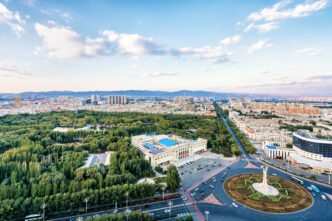Executive Summary
The Story So Far
Why This Matters
Who Thinks What?
For the first time in over two decades, Chinese importers have ceased purchasing soybeans from the autumn U.S. harvest, a direct consequence of an escalating trade war that has made American supplies too costly. This unprecedented halt in sales is inflicting severe financial hardship on U.S. farmers, particularly in major producing states like Illinois, and is forcing the industry to seek alternative, albeit significantly smaller, markets globally.
Economic Fallout for U.S. Agriculture
The absence of China, historically the world’s largest soybean importer, has led to a significant downturn in U.S. agricultural exports. From January to July, before the autumn harvest began, U.S. soybean exports to China dropped 39% by volume to 5.9 million metric tons and 51% by value to $2.5 billion, according to government data.
Farmers are now storing much of their crops, hoping for future price increases from around a five-year low. This delay in sales impacts their ability to generate income while facing rising operational costs. In Illinois, growers are reportedly facing losses of up to $8 per acre due to low prices and weak exports.
The financial strain extends beyond farms to agricultural businesses. Equipment manufacturer CNH, which sells tractors and combines, reported a 20% drop in net sales for its agriculture business in the first six months of the year compared to the previous year. The mayor of Decatur, Illinois, once known as the “soy capital of the world,” suggested that title might now belong to Brazil.
Tariffs Drive Market Shift
The core issue stems from tit-for-tat tariffs imposed by Washington and Beijing. China’s 23% tariff on U.S. soybean shipments adds approximately $2 a bushel to the cost for importers, making American soybeans uncompetitive. As a result, Chinese buyers have shifted their purchases to South American suppliers like Brazil and Argentina.
President Trump has acknowledged the impact, stating on Truth Social that “The Soybean Farmers of our Country are being hurt because China is, for ‘negotiating’ reasons only, not buying.” He indicated that soybeans would be a key discussion point in upcoming talks with Chinese President Xi Jinping. U.S. Treasury Secretary Scott Bessent also announced that the government would make an announcement regarding support for farmers.
Seeking Alternative Markets
In response to the market disruption, the U.S. administration and industry groups are actively pursuing new export opportunities. Trade missions have been conducted to countries such as Nigeria, Vietnam, Turkey, and Saudi Arabia, with memorandums of understanding signed with nations like Vietnam for over $1.4 billion in U.S. farm products, including soybeans.
However, these alternative markets are comparatively small. For instance, a significant increase in exports to Bangladesh amounted to just over 400,000 tonnes, a fraction of China’s typical demand. Despite rising shipments to Vietnam, Egypt, Thailand, and Malaysia, total U.S. soybean exports were down 8% by volume from the same period a year ago.
U.S. Agriculture Secretary Brooke Rollins stated on social media that Taiwan committed to $10 billion in U.S. agriculture purchases over the next four years. However, the article notes this commitment would not represent an increase, as U.S. agricultural exports to Taiwan in a recent year totaled $3.8 billion, which would amount to $15 billion over four years at that pace.
The Challenge of Replacing China
Replacing China as a soybean buyer presents a formidable challenge. With over 1.4 billion people and the world’s largest hog herd, China has historically imported an average of 61% of the world’s traded soybean supplies over the past five years, more than the rest of the world combined. In a recent year, U.S. exports to China reached nearly 27 million metric tons, compared to 5 million metric tons to Mexico, the second-largest buyer.
Farmers remain hopeful that current efforts to diversify markets will yield long-term benefits, but the immediate struggles are profound. Caleb Ragland, a Kentucky farmer and president of the American Soybean Association, described the situation as “overwhelming frustration.”








